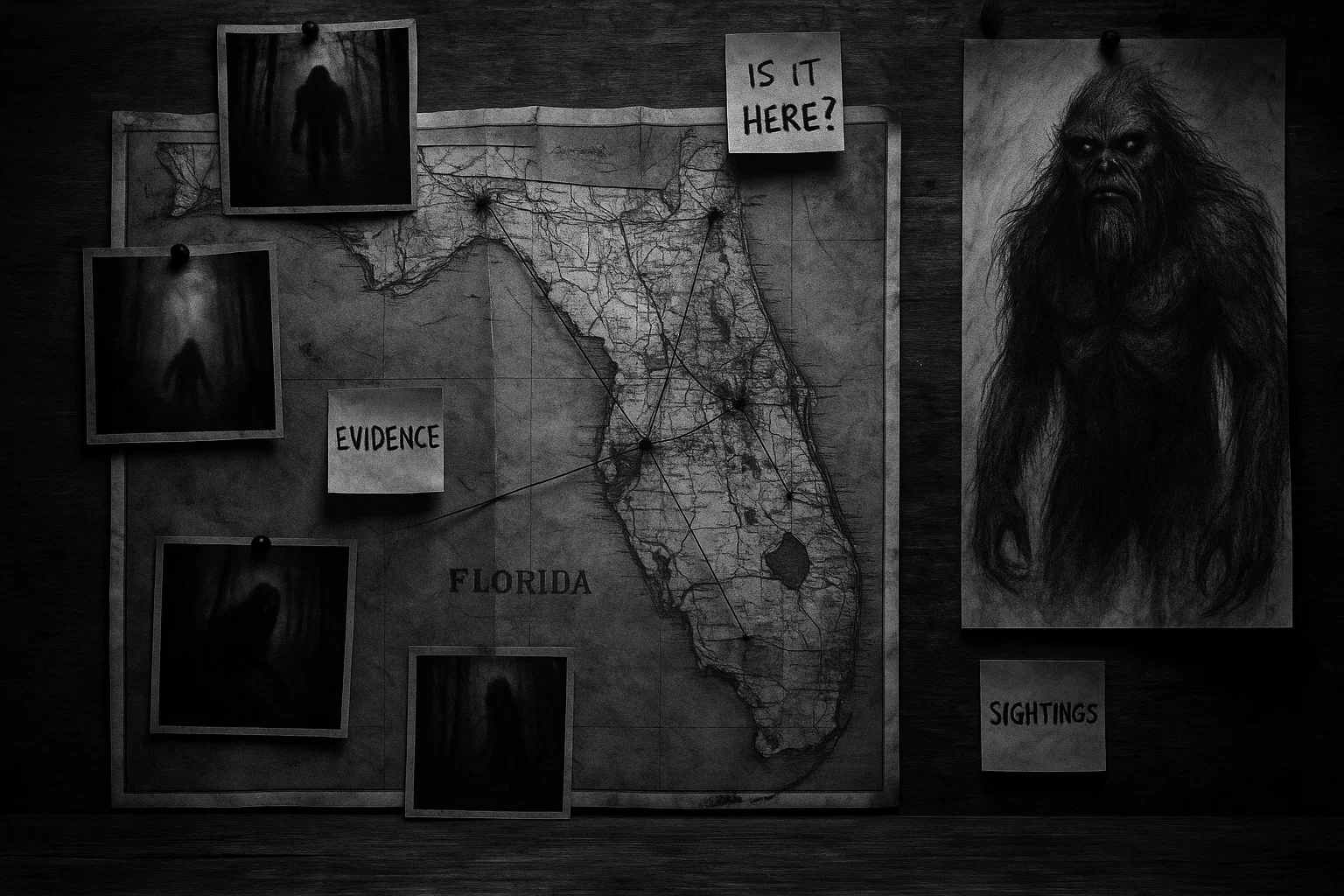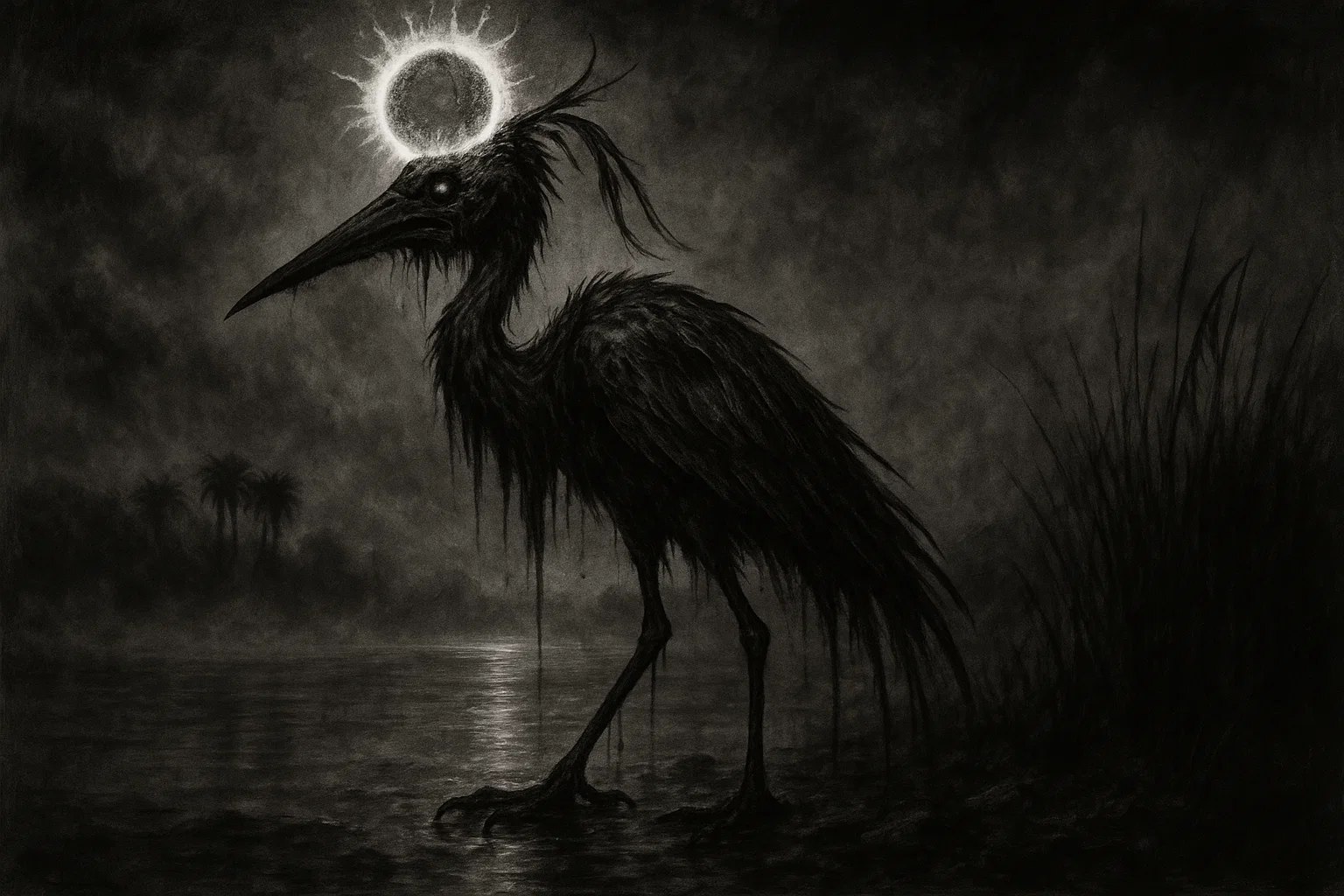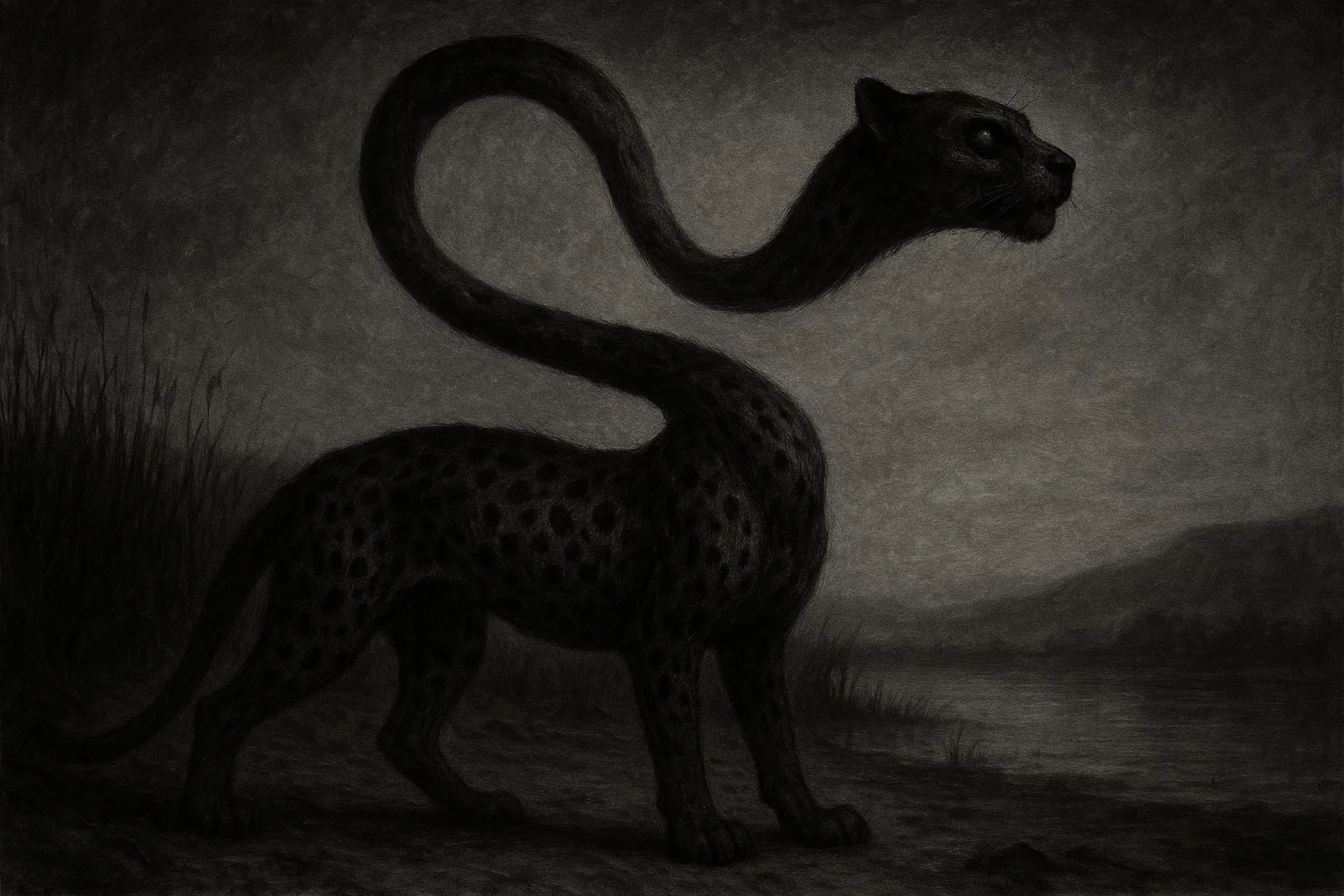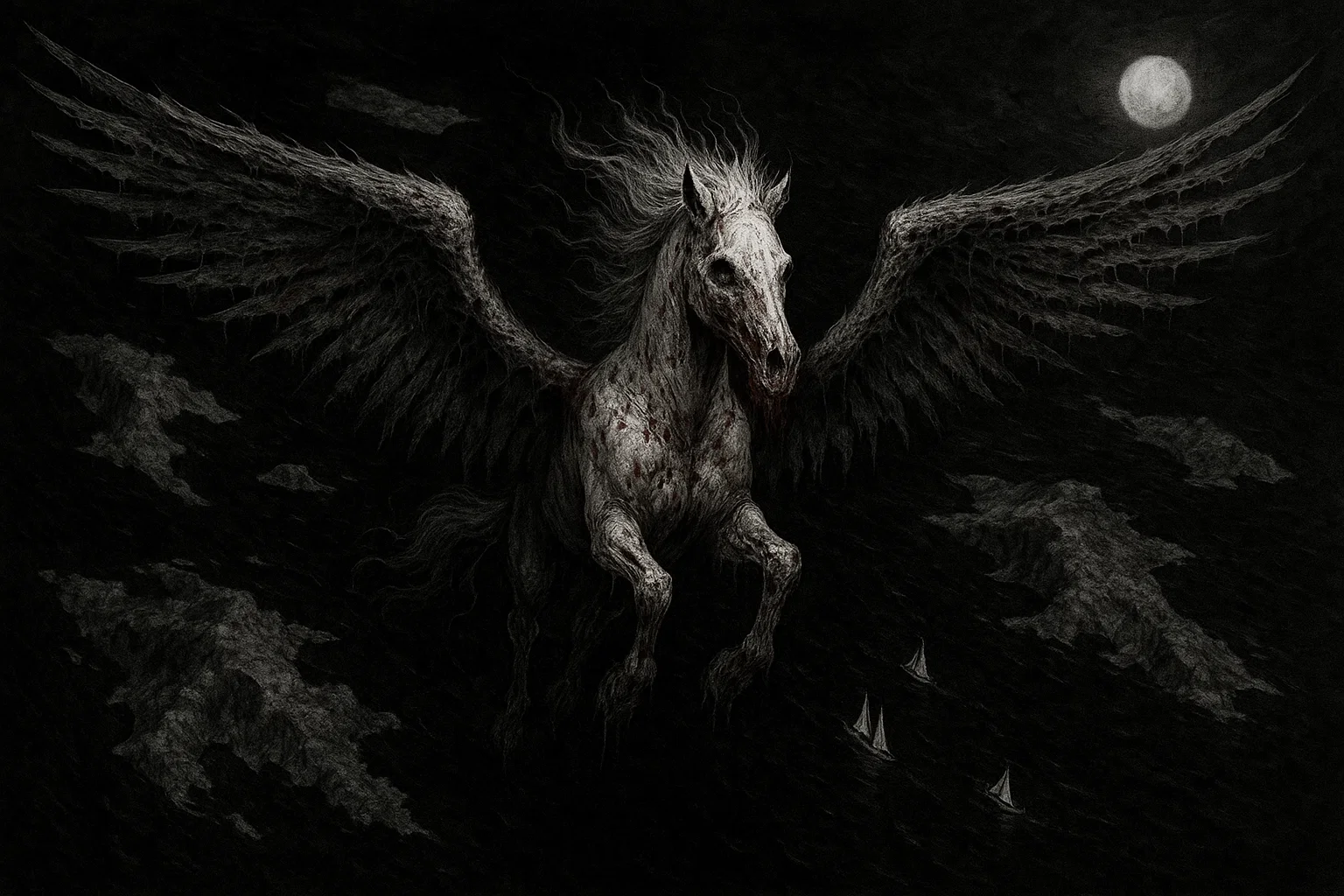Florida, a land of sun-drenched beaches, sprawling wetlands, and dense forests, is home to one of America’s most enduring cryptid legends: the Skunk Ape, the state’s own version of Bigfoot.
With over 344 documented sightings, Florida ranks third in the United States for Bigfoot encounters, trailing only California and Washington. These reports, spanning from 1818 to 2024, describe a bipedal, hairy creature with a pungent odor, often lurking in the Everglades, Ocala National Forest, and rural Panhandle regions.
This article delves deeply into Florida Bigfoot sightings, exploring their history, key investigations, detailed case studies, comparisons with other cryptids, and their cultural significance. By weaving together historical accounts, witness testimonies, and ongoing research, we aim to provide a comprehensive and engaging exploration of this elusive creature.
Summary
Florida Bigfoot Sightings
The Skunk Ape, Florida’s Bigfoot, is a cryptid steeped in mystery, reported across the state’s swamps, hammocks, and pine forests. Named for its foul smell—often likened to rotten eggs, wet dog, or sulfur—this creature is described as 5–12 feet tall, with reddish-brown to black fur, long arms, and a reclusive nature.
The Bigfoot Field Researchers Organization (BFRO) has cataloged 344 sightings since 1955, but earlier accounts trace back to the early 19th century, rooted in Native American lore. The Seminole and Miccosukee tribes speak of Esti Capcaki, or “Furry Tall Man,” a secretive, powerful being said to guard the wilderness. Sightings range from fleeting glimpses to detailed encounters, often accompanied by eerie silence, strange vocalizations, or large footprints.
Below is a comprehensive table of some of the most relevant Florida Bigfoot sightings based on available records, organized chronologically from 1818 to 2025:
| Date | Witness | Location | Description |
|---|---|---|---|
| 1818 | Local fishermen | Apalachicola, Franklin County | A newspaper reported a “man-sized monkey” raiding food stores and stalking fishermen along the shore. Covered in dark fur, it moved swiftly and vanished into the forest. |
| 1929 | Construction workers | Perky Bat Tower, Florida Keys, Monroe County | Workers reported a 6-foot, ape-like creature with matted fur drawn to the construction site, emitting a foul odor before retreating into mangroves. |
| July 1957 | Two hunters | Ocala National Forest, Marion County | Hunters observed a 7-foot creature with dark brown fur invade their camp, rummaging through supplies and growling softly. It left 15-inch footprints with a 50-inch stride. |
| August 1966 | Camper | Green Swamp, Polk County | A camper reported a 6-foot, reddish-brown creature watching from the tree line at dusk. It emitted a sulfur-like smell and fled when a flashlight was shone on it. |
| July 1971 | Motorist | Dade County, near Homestead | A driver saw a 7-foot, dark-furred creature cross a road at night, moving upright with long strides. It disappeared into a canal, leaving a foul odor. |
| January 9, 1974 | Richard Lee Smith | U.S. Route 27 and Hollywood Boulevard, Pembroke Pines, Broward County | Smith struck a 7–8-foot, hairy creature with his car. It roared, charged briefly, then limped into the swamp. Police searched with helicopters but found no evidence. |
| July 1974–1975 | Sheriff’s Deputies Marvin Lewis and Ernie Milner | West of Lantana, Palm Beach County | Deputies encountered a 7–12-foot creature with silver-gray to brown fur stalking a citrus grove. They fired shots, hitting it; hair on a barbed wire fence was later analyzed as “unknown species.” |
| 1974–1975 | Multiple residents | Broward County, near Davie | Witnesses reported a 5–7-foot, dark red to black-furred creature in swamps, active at night. It left 14-inch tracks and a skunk-like smell. |
| 1975 | Farmer | Hendry County, near Clewiston | A farmer reported a 6-foot creature stealing corn from fields, described as lean with reddish fur. It fled when dogs barked, leaving broken stalks. |
| November 1977 | Anonymous | Everglades City, Collier County | A wildlife tour operator reported a 7-foot creature raiding lima bean bait stands, leaving four-toed, 16-inch footprints. It moved silently and vanished into the swamp. |
| November 1981 | Family (stepfather, outdoorsman) | Econfina River, Taylor County | A camping family heard hoot owl-like noises and smelled a skunk-like odor. The stepfather saw a 7-foot, dark brown creature; it fled after a warning shot, breaking branches. |
| Spring 1985 | Two boys | Near Bear Creek, Mexico Beach, Bay County | Boys saw an 8-foot, black-furred humanoid standing motionless in woods, retreating silently. A strong odor lingered; no tracks were found. |
| August 1985 | Hunter | Apalachicola National Forest, Liberty County | A hunter reported a 6.5-foot, reddish creature watching from a ridge, emitting a low growl. It left 15-inch tracks and a foul smell before disappearing. |
| 1990 | Park ranger | Myakka River State Park, Sarasota County | A ranger saw a 7-foot, dark-furred creature drinking from a lake at dawn. It moved upright and vanished into palmettos, leaving a musky odor. |
| July 21, 1997 | Jan Brock | Burns Road, Big Cypress National Preserve, Collier County | Brock saw a 6.5–7-foot, shaggy creature cross the road, moving swiftly on two legs with dark, matted fur. It disappeared into dense vegetation. |
| July 21, 1997 | Vince Doerr, Fire Chief | Big Cypress National Preserve, Collier County | Doerr photographed a 7-foot, hairy creature 15 minutes after Brock’s sighting, initially mistaking it for a bear. It stood upright and fled into the swamp. |
| September 8, 1998 | David Shealy | Big Cypress National Preserve, Collier County | Shealy, from a tree stand, saw a 7-foot Skunk Ape splashing through water, with reddish-brown fur. He photographed it and cast a 16-inch, four-toed footprint. |
| July 8, 2000 | David Shealy | Big Cypress National Preserve, Collier County | Shealy filmed a 7-foot Skunk Ape crossing a swamp at 22 mph through 1.5 feet of water. It had dark fur, long arms, and vanished into a palm grove. |
| October 2000 | Off-roader | Southport, Bay County | A woman heard two loud screams near Gulf Power steam plant at 11 p.m., followed by rustling and a strong odor, suggesting a Skunk Ape. |
| Late Spring 2000 | Family (husband, outdoorsman) | Marion County, near Ocala | A family heard an “argh” sound and a “temper tantrum” vocalization near their home. A recorder captured crunching and snapping; a creature killed goats, eating only livers. |
| December 29, 2000 | Elderly woman | Myakka City, Sarasota County | An anonymous woman sent photos to the sheriff’s office of a large, hairy creature stealing apples from her porch near I-75. Dubbed the “Myakka Skunk Ape,” it resembled a primate. |
| March 12, 2002 | Two women | U.S. Highway 98, Walton County | At 2 a.m., after their car broke down, the women heard a scream mixed with moaning. A 7-foot, muscular, brown-black creature stared at them before retreating as cars approached. |
| 2004 | Fisherman | St. Johns River, Putnam County | A fisherman saw a 6-foot, dark-furred creature wading in shallow water, moving upright. It emitted a sulfurous smell and fled when a boat motor started. |
| 2007 | Hiker | Withlacoochee State Forest, Citrus County | A hiker reported a 7.5-foot, reddish-brown creature watching from a ridge, silent but emitting a foul odor. It left 17-inch tracks with a 55-inch stride. |
| 2010 | Camper | Osceola National Forest, Baker County | A camper heard loud whoops and smelled a skunk-like odor at night. A 6.5-foot, dark creature was seen near a creek, fleeing when a flashlight was used. |
| July 2015 | Vacationer | Shell Island, Bay County | A vacationer saw a 7-foot, brown, hairy creature at midday, standing upright before retreating into dense vegetation. No tracks were found due to sandy terrain. |
| November 4, 2012 | Target shooter | Everglades, west of Broward County, Collier County | A man saw a 6.5-foot, dark brown creature peering from behind a tree, 20 feet away, before it fled into the swamp, leaving no tracks. |
| March 2013 | Two brothers | Highway 85, south of Crestview, Okaloosa County | At 1:30 a.m., the brothers saw a 7-foot, black-furred creature resembling a bear but walking upright, crossing the road and vanishing into woods. |
| 2014 | Kayaker | Yellow River, Santa Rosa County | A kayaker reported rocks thrown at him from the swamp, followed by a 7-foot, dark creature watching from the bank. It retreated silently, leaving a foul smell. |
| 2016 | Hunter | Green Swamp, Sumter County | A hunter saw a 6-foot, reddish creature moving through palmettos, emitting a low growl. It left 14-inch tracks and a lingering odor. |
| 2018 | Wildlife tour guide | Everglades National Park, Miami-Dade County | A guide reported a 7-foot, dark-furred creature stalking alligators at dusk, moving bipedally. It vanished into mangroves, leaving a musky smell. |
| 2020 | Motorist | State Road 19, Putnam County | A driver saw a 7.5-foot, slender creature with dark brown fur cross the road in early morning fog, entering thick woods without a visible path. |
| January 28, 2021 | Anonymous | Near Eglin Air Force Base, south of Crestview, Okaloosa County | A video captured a black, human-like figure crossing under power lines in a wooded area, moving upright and disappearing into dense brush. |
| February 23, 2024 | Marie Dumont, Bigfoot researcher | Hammock Campground, Jennings State Forest, Clay County | Dumont’s team found a 0.25-mile trackway of 16-inch, four-toed footprints with a 54-inch stride, ending at a creek. At night, they heard bipedal footsteps and felt their car being pushed. |
You May Also Like: Complete Guide to Alaska Bigfoot Sightings (1985–2025)
Investigation Efforts in Florida
Investigating Florida Bigfoot sightings is a challenging endeavor, blending scientific rigor, amateur enthusiasm, and cultural curiosity. Florida’s vast wilderness, including the Everglades, Green Swamp, and Apalachicola National Forest, provides a complex terrain for researchers seeking evidence of the Skunk Ape.
Several groups and individuals have dedicated decades to studying these sightings, employing diverse methods from footprint casting to advanced technology.
- Bigfoot Field Researchers Organization (BFRO): The BFRO, founded in 1995, is a cornerstone of Skunk Ape research, maintaining a database of 344 Florida sightings. Investigators like Cathy Betz and David Bakara conduct field expeditions, interview witnesses, and classify reports as Class A (clear visual sightings) or Class B (indirect evidence like tracks or vocalizations). The BFRO uses trail cameras, audio recorders, and thermal imaging to document potential evidence, though no definitive proof has emerged. Their work emphasizes systematic data collection, but critics note the lack of physical remains or clear photographs.
- Mid Florida Bigfoot Research Group: Led by Marie Dumont, this group focuses on Central Florida hotspots like the Green Swamp and Ocala National Forest. With over 30 years of tracking experience, they analyze footprints, collect witness testimonies, and monitor environmental signs like broken branches or nesting sites. Dumont’s team has documented trackways, such as the 2024 Clay County find, and uses drone surveillance to explore inaccessible areas. They hypothesize that Skunk Apes may use alligator holes as dens, explaining their elusive nature.
- Skunk Ape Research Headquarters: Located in Ochopee, Collier County, this center, founded by David Shealy, is a hub for Skunk Ape research and tourism. Shealy, who claims four sightings since 1973, displays plaster casts of four-toed footprints, photos, and a 2000 video purportedly showing a Skunk Ape. The headquarters offers eco-tours, encouraging visitors to report sightings while promoting conservation of the Everglades. Shealy’s 2024 “Year of the Skunk Ape” campaign boosted visibility, with the center voted a top U.S. roadside attraction. However, skeptics question the authenticity of his evidence, citing potential hoaxes.
- Gulf Coast Bigfoot Research Organization (GCBRO): Active in Northwest Florida, the GCBRO investigates sightings in counties like Okaloosa and Bay. Their approach includes night patrols, baiting with food like lima beans, and analyzing physical evidence like hair or scat. In 2013, they investigated a Crestview sighting, finding disturbed vegetation but no conclusive proof. The GCBRO emphasizes community engagement, encouraging locals to share encounters without fear of ridicule.
- Independent Researchers and Cryptozoologists: Individuals like Connor Flynn, an Altha-based cryptid hunter, contribute through books, YouTube videos, and field investigations. Flynn’s work, including “Bigfoot Anon” videos, explores Bay County sightings and suggests Skunk Apes may possess supernatural traits like echolocation. Loren Coleman, a prominent cryptozoologist, proposed in 1973 that the Skunk Ape might belong to the extinct genus Dryopithecus, sparking debate among enthusiasts. Local wildlife tour operators, such as those in Everglades City, also report sightings during tours, using their knowledge of the terrain to guide researchers.
Challenges persist, including Florida’s humid climate, which degrades evidence like footprints, and the scientific community’s skepticism. The Florida Fish and Wildlife Conservation Commission denies official records of Skunk Ape sightings, suggesting misidentifications of bears or hogs.
Despite this, researchers use modern tools like drones, thermal imaging, and audio analysis to refine their methods. Events like the Great Florida Bigfoot Conference, held annually in Ocala, bring together enthusiasts, researchers, and witnesses to share findings, fostering a community dedicated to solving the Skunk Ape mystery.
Detailed Case Studies
1974–1975 Palm Beach County Sightings
The 1974–1975 Skunk Ape sightings in Palm Beach County, particularly west of Lantana, stand as one of Florida’s most compelling cases due to multiple witnesses, law enforcement involvement, and physical evidence. Reported to the BFRO (Report ID 414), the encounters unfolded over several months in a rural area near the Everglades, during a period of record drought and wildfires that may have driven wildlife closer to human settlements.
The primary witnesses were sheriff’s deputies Marvin Lewis and Ernie Milner, alongside a family and neighbors. In July 1974, the family noticed mangoes, oranges, and other fruits disappearing from their trees, initially suspecting thieves.
Soon, they observed three distinct creatures: a juvenile, about 7 feet tall with brown fur; a “father,” approximately 12 feet tall with silver-gray fur; and a “mother,” 8–10 feet tall with brownish-gray fur.
Each had long arms, minimal necks, and emitted a skunk-like odor. The creatures moved silently, often appearing at dusk or night, and were seen peering into windows, startling livestock, and rummaging through supplies.
A notable incident occurred when the family’s horses became agitated, rearing and snorting as the creatures approached. One night, the “father” picked up a 100-pound hog, bit into its side, and consumed only the liver, leaving the carcass behind. The family, alarmed, contacted the Palm Beach County Sheriff’s Office.
Deputies Lewis and Milner responded, encountering a 12-foot creature in a citrus grove. They fired multiple shots, striking it at close range, but it only rubbed the impact site and fled at high speed. Following its trail, they found a pushed-down barbed wire fence with hair samples, later analyzed in Miami as belonging to an “unknown species.”
The analysis, conducted by a local lab, noted the hair’s coarse texture and unusual structure, but lacked the technology to identify DNA.
Neighbors corroborated the sightings, with one mistaking the juvenile for a tall man stealing fruit, prompting another police call. A deputy reportedly saw the “father” creature, describing it as massive, upright, and covered in silver-gray fur.
The drought and wildfires of 1974 likely reduced food sources, pushing the creatures toward human areas, explaining the frequency of encounters. Despite extensive searches, including foot patrols and aerial surveillance, no body was found, and the case remains unresolved.
The involvement of law enforcement and physical evidence makes this case a cornerstone of Skunk Ape lore, though skeptics suggest the creatures were misidentified bears suffering from mange.
You May Also Like: Complete Guide to Connecticut Bigfoot Sightings (1953–2025)
November 1981 Taylor County Sighting
The November 1981 sighting near the Econfina River in Taylor County (BFRO Report ID 1423) is another significant case, notable for its vivid details and environmental context. A family camping near Perry experienced a chilling encounter that began with subtle signs and escalated into a direct sighting, reinforcing the Skunk Ape’s elusive reputation.
The family, consisting of a couple, their children, and a stepfather, set up camp in a remote area along the Econfina River, known for its dense forests and minimal human traffic.
On the first night, they noticed an eerie silence, with no typical nocturnal sounds like crickets or frogs. A faint skunk-like odor lingered, initially dismissed as swamp gas. Around midnight, they heard hoot owl-like vocalizations, distinct from any known owl species, followed by a sensation of being watched. The stepfather, an experienced outdoorsman, grew uneasy and kept a rifle nearby.
At dawn, the family awoke to find broken branches and disturbed vegetation around their campsite, with no clear animal tracks. The odor intensified, described as a mix of wet dog and decay. As they prepared to leave, the stepfather spotted a 7-foot-tall, hairy figure standing 50 yards away near a cypress tree.
Covered in dark brown fur, it had a broad chest, long arms, and a flattened face with dark eyes. He fired a warning shot into the air, prompting the creature to emit a low, guttural growl before crashing through the underbrush, snapping branches as it fled. The family found no footprints due to the hard, root-covered ground, but the broken vegetation and lingering smell corroborated their account.
The sighting, reported to the BFRO, was classified as Class A due to the clear visual encounter and the witness’s credibility as an experienced outdoorsman. Investigators noted the area’s suitability as a Skunk Ape habitat, with ample cover and water sources.
The vocalizations and odor align with other Florida sightings, though skeptics suggest the figure could have been a bear or a transient in tattered clothing. The family’s detailed account and the environmental context make this a standout case in Skunk Ape research.
Bigfoot Sightings vs Other Cryptid Sightings in Florida
Florida’s rich cryptid landscape extends beyond the Skunk Ape, encompassing a variety of mysterious creatures rooted in folklore and eyewitness accounts.
These cryptids, while distinct, share Florida’s wild spaces, contributing to a tapestry of unexplained phenomena. Below are key cryptids reported in the state, along with their characteristics, locations, and possible connections to Skunk Ape sightings.
- Wampus Cat: A feline-like creature from Appalachian and Native American folklore, reported in North Florida’s rural areas, particularly Putnam and Alachua Counties. Described as a large cat with glowing yellow eyes, sharp claws, and supernatural speed, it is said to emit terrifying screams. Sightings, such as one in 1965 near Gainesville, describe a 5-foot-long creature stalking livestock at twilight. Its shape-shifting abilities in legend contrast with the Skunk Ape’s primate-like form, suggesting no direct link, though both thrive in dense forests.
- Florida Mothman: A winged humanoid with red eyes and a 10-foot wingspan, reported near Tampa and along rural highways like I-75. A 1988 sighting in Pinellas County described a creature hovering over a car at night, emitting a high-pitched screech. Unlike the terrestrial Skunk Ape, the Mothman’s aerial nature sets it apart, though both are nocturnal and tied to remote areas, possibly reflecting a shared cultural fascination with the unknown.
- Borinkus: A sea serpent reported in the St. Johns River, particularly in the early 20th century. Described as 20–30 feet long, dark brown, and snake-like, a 1915 sighting near Palatka reported it overturning a small boat. Its aquatic habitat contrasts with the Skunk Ape’s terrestrial domain, ruling out direct connections, though both contribute to Florida’s cryptid lore.
- Mega Alligator: Legends of oversized alligators, such as “Hog Kong,” a 1,000-pound specimen killed in 2004 near Okeechobee, blur fact and myth. Reported in swamps and golf courses, these creatures are grounded in reality but exaggerated in folklore. Unlike the bipedal Skunk Ape, they lack shared traits beyond inhabiting wetlands.
- Bardin Booger: A North Florida cryptid from Putnam County, first reported in 1947 near Bardin. Described as a 10-foot, furry, monkey-like creature, often seen with a lantern, it resembles the Skunk Ape in appearance but is tied to specific local tales. A 1970 sighting described it chasing a horse, suggesting predatory behavior absent in most Skunk Ape reports. The lantern detail may stem from misidentified lights or human activity, but the creature’s primate-like form hints at a regional Bigfoot variant.
Other unexplained phenomena in Florida include ghostly apparitions in St. Augustine’s historic district, UFO sightings along the Gulf Coast, and reports of a “Cyclopean creature” near Panama City Beach in 2005, described as a one-eyed humanoid.
These differ significantly from Skunk Ape sightings, which focus on a physical, primate-like entity. While overlapping locations like the Everglades suggest Florida’s wilderness fosters diverse legends, no concrete evidence links these cryptids. The shared theme of elusiveness may reflect human tendencies to anthropomorphize natural phenomena or misinterpret wildlife in low-visibility settings.
You May Also Like: Complete Guide to Delaware Bigfoot Sightings (1892–2025)
Conclusion
The Skunk Ape remains one of Florida’s most enduring mysteries, with 344 documented sightings weaving a narrative of intrigue across centuries. From the earliest accounts in 1818 to recent trackways in 2024, the creature’s consistent description—tall, hairy, foul-smelling—captivates believers and skeptics alike.
Investigation efforts by the BFRO, Mid Florida Bigfoot Research Group, and David Shealy’s Skunk Ape Research Headquarters highlight a passionate quest for truth, despite the absence of definitive proof.
Cases like the 1974–1975 Palm Beach County sightings and the 1981 Taylor County encounter underscore the depth of witness experiences, while Florida’s broader cryptid lore enriches the cultural context.
The Skunk Ape symbolizes Florida’s untamed wilderness and human curiosity about the unknown.
Whether a real creature, a misidentified animal, or a product of folklore, it inspires exploration and debate. As researchers continue to probe the swamps and forests, the legend of the Skunk Ape endures, inviting us to ponder what mysteries still lurk in the Sunshine State’s wild heart.







